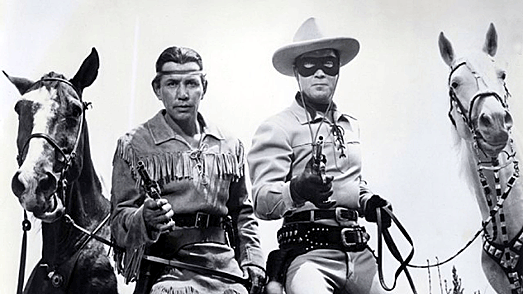
Let’s face it, the 1950s were boring, especially for
kids. They didn’t have video games or computers. They couldn’t watch
shows on Netflix. They didn’t have the million and one distractions
that they have today to occupy their idol hours. But they did have
T.V., a new medium that just a few years before exploded onto
post-war America. And one of the types of shows they watched the
most was the early T.V. western.
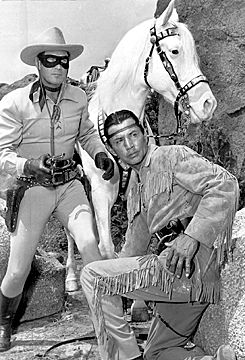 How
many kids sat glued in front of their T.V. sets as they heard, “Hi,
ho, Silver, away!” and watched the Lone Ranger, the masked rider of
the plains, along with his faithful Indian sidekick, Tonto, ride
down a dusty trail into a new adventure to the stirring strains of
the William Tell Overture. Most sat close to the screen—presumably
to get “into” the action—which prompted concerned parents to warn
that doing so would hurt their eyes. Many spent many hours
enthralled by the cowboys and Indians, lawmen and desperados, as
they played out hair-raising adventures on the screen.
How
many kids sat glued in front of their T.V. sets as they heard, “Hi,
ho, Silver, away!” and watched the Lone Ranger, the masked rider of
the plains, along with his faithful Indian sidekick, Tonto, ride
down a dusty trail into a new adventure to the stirring strains of
the William Tell Overture. Most sat close to the screen—presumably
to get “into” the action—which prompted concerned parents to warn
that doing so would hurt their eyes. Many spent many hours
enthralled by the cowboys and Indians, lawmen and desperados, as
they played out hair-raising adventures on the screen.
And while all of the early westerns may have seemed to be aimed at
young, impressionable audiences— some of the stars even addressed
the youngsters, usually between the ages of six and eight, at the
ends of their shows—the shows, themselves, had adult themes and lots
of violence. The number of people who died from gunshot wounds alone
was staggering.
TV producers set early westerns primarily in the later half of the
19th century in the American Old West, during the period from about
1860 to the end of the so-called "Indian Wars." Many of the
characters portrayed, especially the bad ones, were former
Confederate soldiers who traveled west seeking their fortunes.
Story lines, costumes, and sets, though realistic, portrayed an Old
West of Hollywood’s imagination rather than stories based on
extensive research. Westerns today might be classified as
naturalistic, featuring a myriad of researched details that bring
those times truly alive to the viewer.
The peak year for television westerns was 1959 when 26 aired during
prime time. In one week in March 1959, eight of the top ten shows
were westerns. Increasing costs of production—a horse cost up to
$100 a day—led to most action half-hour series vanishing in the
early 1960s to be replaced by hour long T.V. shows, increasingly in
color.
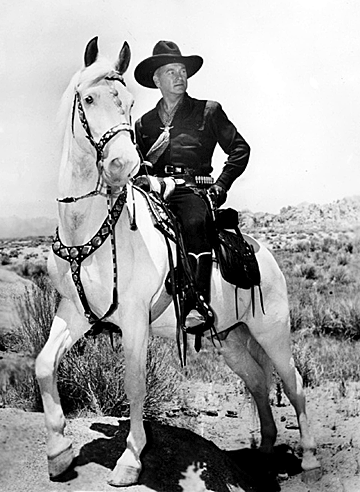 On
June 24, 1949, Hopalong Cassidy, played by William Boyd, and his
horse Topper, rode across the small screen and into the homes of
western film lovers to become the first of a series of TV westerns.
Soon others, such as Gunsmoke, Cheyenne, and The Lone Ranger
followed. From 1949 to the late '60s, there were over 100 western
series that aired on the networks.
On
June 24, 1949, Hopalong Cassidy, played by William Boyd, and his
horse Topper, rode across the small screen and into the homes of
western film lovers to become the first of a series of TV westerns.
Soon others, such as Gunsmoke, Cheyenne, and The Lone Ranger
followed. From 1949 to the late '60s, there were over 100 western
series that aired on the networks.
Before television, the nation saw westerns at movie theaters and
listened to them over the radio. When westerns started appearing on
TV, viewers avidly waited for their favorites. In any one week,
westerns often received the highest viewer ratings. Viewers were
able to escape their humdrum lives to watch their favorite heroes
overcome all adversaries. It was good vs. bad, hero vs. villain, in
the Old West.
But it was much more than that. Early TV western series helped
define America as a nation. Westerns sought to teach the good values
of honesty and integrity, of hard work, of racial tolerance, of
determination to succeed, and of justice for all. They were, in a
sense, modern morality plays where heroes, strong, reliable,
clear-headed and decent, fought their adversaries in the name of
justice. At the show's end, moral lessons had been taught and
learned.
The Lone Ranger became particularly popular, especially with young
audiences. He personified all that was good in people. He and Tonto
would always save the day without sticking around for a "thank you."
The Lone Ranger and Tonto had a strong sense of civil responsibility
and humanitarianism and didn't need thanks for doing what they felt
was their moral obligation. The Lone Ranger series would carry the
theme of racial tolerance, a theme that was prevalent in many
western series.
Hopalong Cassidy was a fictional cowboy hero created in 1904 by the
author Clarence E. Mulford, who wrote a series of popular short
stories and many novels based on the character. In his early
writings, Mulford portrayed the character as rude, dangerous, and
rough-talking. Beginning in 1935, the character—as played by movie
actor William Boyd—transformed the character into a clean-cut hero
in 66 films adapted from Mulford's book. In the first film, Hopalong
Cassidy got his name after being shot in the leg. Hopalong's "drink
of choice" was the nonalcoholic sarsaparilla.
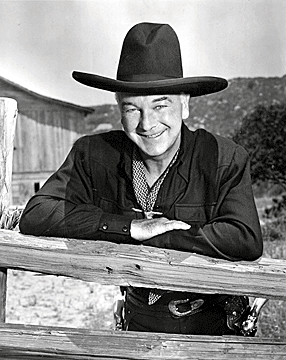 As
portrayed on the screen, the white-haired Bill "Hopalong" Cassidy
usually wore a black outfit and hat, an exception to the
longstanding western film stereotype that only villains wore black
hats. Reserved and well spoken, with a fine sense of fair play, he
often interceded when dishonest characters were taking advantage of
honest citizens. "Hoppy" and his white horse, Topper, usually
traveled through the west with two companions—one young and trouble
prone with a weakness for damsels in distress, the other comically
awkward and outspoken.
As
portrayed on the screen, the white-haired Bill "Hopalong" Cassidy
usually wore a black outfit and hat, an exception to the
longstanding western film stereotype that only villains wore black
hats. Reserved and well spoken, with a fine sense of fair play, he
often interceded when dishonest characters were taking advantage of
honest citizens. "Hoppy" and his white horse, Topper, usually
traveled through the west with two companions—one young and trouble
prone with a weakness for damsels in distress, the other comically
awkward and outspoken.
Boyd, who thought Hopalong Cassidy might have a future in
television, spent $350,000 to obtain the rights to his old films and
approached the fledgling NBC television network. The initial
broadcasts were so successful that NBC couldn’t wait for a
television series to be produced and simply reedited the old feature
films down to broadcast length.
The series and character were so popular that national magazines,
such as Look, Life, and Time featured Hopalong Cassidy on their
covers. Boyd earned millions as Hopalong—$800,000 in 1950
alone—mostly from merchandise licensing and endorsement deals. In
1950, Aladdin Industries featured Hopalong Cassidy on the first
lunchbox to bear an image, causing sales to jump from 50,000 units
to 600,000 units in just one year. In stores, more than 100
companies in 1950 manufactured $70 million of Hopalong Cassidy
products, including children's dinnerware, pillows, roller skates,
soap, wristwatches, and jackknives.
Boyd began work on a separate series of half-hour westerns made
especially for television; Edgar Buchanan was his new sidekick, Red
Connors, a character from the original stories and a few of the
early films. The success of the show and tie-ins inspired several
juvenile television westerns, such as The Range Rider, Tales of the
Texas Rangers, Annie Oakley, The Gene Autry Show, and The Roy Rogers
Show.
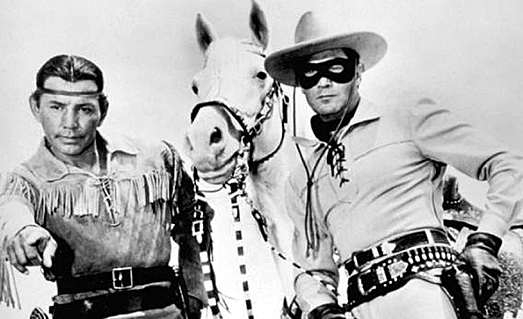
The Lone Ranger, starring Clayton Moore with Jay Silverheels as
Tonto, ran from 1949 to 1957. This was by far the highest-rated
television program on the ABC network in the early 1950s and its
first true hit. The first 78 episodes were produced and broadcast
for 78 consecutive weeks without any breaks or reruns. Then ABC
broadcast the entire 78 episodes again before any new episodes were
produced. Shooting took place in Kanab, Utah and California, as well
as at the Iverson Movie Ranch in Chatsworth, California.
When it came time to produce another batch of 52 episodes, there was
a wage dispute with Clayton Moore, so the producers hired John Hart
to play the role of the Lone Ranger from 1952 to 1954. After a
change of producers in 1954, the new producer hired Moore back and
made 52 new episodes.
The final season saw a number of changes, including a switch to the
industry standard of 39 episodes. The producer, Jack Wrather
invested money out of his own pocket to film in color and went back
outdoors to film most of the action, instead of filming mostly on
soundstages. The last new episode of the color series appeared on
June 6, 1957, and the series ended three months later.
Traditional Westerns began to disappear from television in the late
1960s and early 1970s as color television became common. The last
season any new traditional Westerns debuted on television was 1968,
and by 1969, after pressure from parental advocacy groups who
claimed Westerns were too violent for T.V., all three major networks
ceased airing new Western series.
NEW!
Watch a film clip from the iconic Long Ranger TV series.
